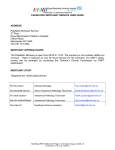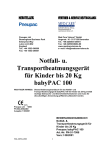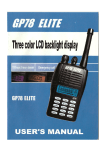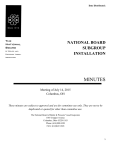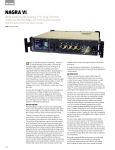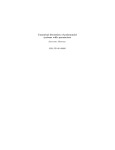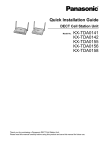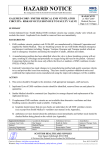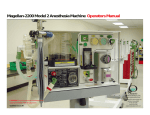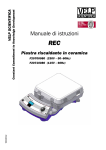Download Journal template - Rubicon Research Repository
Transcript
Rubicon Research Repository (http://archive.rubicon-foundation.org) South Pacific Underwater Medicine Society (SPUMS) Journal Volume 32 No. 2 June 2002 62 ORIGINAL PAPERS EVALUATION OF THE CAMPBELL EV 500 VENTILATOR UNDER HYPERBARIC CONDITIONS flow through fixed orifices within the ventilator decreases and increased pressure is required to overcome airway resistance and inflate the patient’s lungs. Radha McKay and Michael Bennett 2 Any ventilator needs to comply with the strict fire safety regulations for safety in a hyperbaric chamber. These specify that the electrical power supply must be no greater than a 12 volt DC battery, no flammable lubricants that could act as a fuel source should be used within the ventilator and the percentage of oxygen within the chamber be kept at less than 23%. Key Words Hyperbaric research, ventilators. Abstract The Campbell EV 500, an Australian anaesthesia ventilator, was tested in a hyperbaric chamber using a lung analogue as patient simulation. Three modes of ventilation were assessed: time-cycled, pressure-cycled and timecycled/volume preset. The ventilator was adjusted to deliver a set tidal volume at 100 kPa and tidal volume (TV), inspiratory time, rate and inspiratory pressures were measured as chamber pressure increased. Time-cycled/ volume preset was the only mode that delivered consistent minute ventilation over a wide range of compliance and resistance settings. With one exception, mean tidal and minute volume remained within 10% of the original value, inspiratory time and rate were unaffected by the increase in ambient pressure and inspiratory pressures were within clinically acceptable limits (7 to 25 cm H2O). The exception occurred at a pressure (400 kPa) greater than any treatment pressure that we currently use in our facility with the use of a high set tidal volume (1,000 ml) and a low lung compliance (12.5 ml/cm H2O). Accurate control of inspiratory time, rate and tidal volume contributed to the ability to provide consistent minute ventilation. The ventilator compared favourably with others previously reported in the literature. 3 Any enclosed gas pockets within the ventilator mechanism (for example, hermetically sealed transistors) may be damaged during compression and decompression. 4 Hyperbaric chambers tend to be small, with limited space for any equipment. 5 Because the patient is often cared for by a lone attendant, it is desirable that the ventilator requires as little adjustment as possible when the pressure within the chamber alters, leaving the attendant free to react quickly to a patient’s changing clinical condition. In view of these problems, and despite the fact that there have been some ventilators specifically designed for hyperbaric use, to date there is no “ideal” ventilator available for use in hyperbaric chambers. There is a suggestion, however, that volume-preset ventilators are, as a class, superior to others. Blanch et al., in the largest comparative ventilator study to date, found that volume-preset ventilators outperformed other classes of ventilator in maintaining tidal volume, rate and inspiratory times over a wide range of ambient pressures with the Oxford Penlon being the best of these.3,9 Introduction For the past two to three decades there have been sporadic descriptions in the literature of mechanical ventilation in the hyperbaric environment.1-11 In recent years, with increased indications for use of hyperbaric oxygen therapy, the number of critically ill patients requiring mechanical ventilation in the chamber has grown. During this time intensive care ventilators have become more sophisticated but there has been a relative lack of progress made in the development of ventilators for hyperbaric use. There are a number of reasons for this. The hyperbaric chamber provides particular challenges for mechanical ventilation. 1 Gas density increases proportionately as ambient pressure increases.12 As gas density increases, turbulent This paper describes the evaluation of the Campbell EV 500 ventilator under hyperbaric conditions up to an ambient pressure of 400 kPa (4 Atmospheres absolute). Although this ventilator is not specifically designed for hyperbaric use, it has a number of features that make it a desirable candidate for assessment. These include compatibility with fire safety regulations, compact size, pneumatic power by either air or oxygen and the ability to operate in a volume-preset mode. Assessment involved measurement of tidal volume, inspiratory time, rate and inspiratory pressure in the three different ventilatory modes available and evaluation of the ability of the ventilator to function under the varied lung compliance and resistance settings likely to be encountered in clinical practice. Our hypothesis was that with this ventilator, tidal volume would remain in clinically acceptable ranges under hyperbaric conditions. Rubicon Research Repository (http://archive.rubicon-foundation.org) South Pacific Underwater Medicine Society (SPUMS) Journal Volume 32 No. 2 June 2002 63 Materials and Methods The Campbell EV 500 Ventilator (ULCO Medical, Marrickville, New South Wales) is a time-cycled, gas driven machine which is primarily used as an anaesthetic ventilator (Fig 1). It is divided into two main systems, electronic and pneumatic. Inspiratory and expiratory times are controlled electronically using a microcontroller that generates timing signals using a quartz crystal oscillator. This, in turn, controls pneumatic valves that allow gas flow. The electronic system also powers the battery charger, the alarm system and the pressure transducer used during pressure-cycled mode. Due to strict fire safety requirements when operating within the hyperbaric chamber, the ventilator is powered by a 12 volt DC battery (life 10 hours). There is a 6 volt DC back-up battery (life 3 hours) if power is low. The batteries are automatically recharged when the ventilator is connected to a 240 volt AC mains power supply. The pneumatic system is designed to be powered by a driving gas of medical air or oxygen at 350 – 450 kPa, the standard operating theatre supply line pressure. The ventilator trials were undertaken using 100% oxygen both as a driving gas and in the patient circuit. Two minor modifications were made to the gas delivery system to improve its utility under hyperbaric conditions. Initially, a regulator designed by the manufacturer to keep driving pressure at 800 kPa (allowing 400 kPa driving pressure at chamber pressure of 400 kPa) lost pressure unexpectedly. This problem was solved by connecting the ventilator directly to the chamber oxygen line so bypassing the faulty regulator. The driving pressure was then maintained by altering the line pressure to 400 kPa above chamber pressure by a direct link with the chamber control systems. Secondly, the flowmeter used in the patient circuit was not accurate at low flows (below 2 l/ min) and a flowmeter calibrated for low flows has subsequently been acquired for use with the ventilator. Figure 1. Campbell EV 500 ventilator with bellows attachment. The ventilator was set up to operate in 3 different modes; time-cycled, pressure-cycled and time-cycled/ volume-preset (Table 1). In the first two modes the driving gas also provides gas for ventilation and during passive exhalation gas is vented into the chamber via an expiratory valve. In the time-cycled mode, the inspiratory/expiratory TABLE 1 SUMMARY OF VENTILATOR MODES Mode Circuit Inspiratory Time/Rate Tidal Volume Pressure Limit Time-cycled (TC) Driving gas powers ventilator and ventilates patient Set electronically Set at surface using inspiratory time and pressure. Upper limit 60 cm H2O Pressure-cycled (PC) As above Dependent on time to reach pressure limit Set at surface using pressure limit 25 cm H2O Time-cycled/ Volume-limited (TC/VL) Driving gas compresses bellows. Separate patient circuit Set electronically Set by limiting excursion of the bellows Upper limit 60 cm H2O Rubicon Research Repository (http://archive.rubicon-foundation.org) 64 South Pacific Underwater Medicine Society (SPUMS) Journal Volume 32 No. 2 June 2002 times and rate are set electronically allowing tidal volume (TV) and inspiratory pressure to vary as ambient pressure changes. In pressure-cycled mode, inspiratory time and pressure are set to maximum and the upper limit LED is set to the required switching pressure. When the cut-off pressure is reached the ventilator cycles into expiration. Rate is determined by the time taken to reach the pressure limit in the inspiratory phase in combination with the expiratory time and not the rate that is displayed on the ventilator (the rate set for time-cycled mode). In the time-cycled/volume-limited mode a rising bellows is added to the ventilator and this can be adjusted to deliver any tidal volume between 25 and 1,300 ml (Fig 1). The driving gas is used to compress the bellows during the inspiratory phase and a separate patient circuit provides one way flow around the circle system for ventilation and CO2 absorption. Oxygen is supplied to the patient circuit by a ball flowmeter and need only be set at low flow to replace oxygen consumption once the patient has been denitrogenated. In practice we usually set flows at 2 l/min to provide oxygen for metabolic and therapeutic needs and to overcome any minor leaks in the circle. Inspiratory time and rate are set electronically with inspiratory time long enough to allow the bellows to empty completely. Other features of the ventilator include a maximum pressure limit of 60 cm H2O, the ability to provide PEEP (positive end expiratory pressure) to 20 cm H2O (not tested under hyperbaric conditions in this study) and a flow control. This has the ability to change the inspiratory characteristics of the ventilator from a flow generator to a pressure generator or any selected position in between these two extremes. This control was left in the mid position and not altered during the trials. The ventilator performance was assessed by an observer within a multiplace hyperbaric chamber in the Department of Diving and Hyperbaric Medicine at the Prince of Wales Hospital, Randwick, NSW, at pressures of 100, 130, 240, 280 and 400 kPa. Observation time was limited to 15 minutes, the maximum time allowed for a nodecompression dive to 400 kPa using Canadian DCIEM dive tables. The maximum pressure of 400 kPa was chosen as it was considered to exceed the greatest possible pressure at which 100% oxygen would be used to ventilate a patient. Patient simulation was provided by a lung analogue (Michigan Instruments, Grand Rapids, Michigan) in which both compliance and resistance were adjustable. We evaluated ventilator function at lung compliances of 50, 25 and 12.5 ml/cm H2O/lung and airway resistances of 2.48 and 5.44 cm H2O/litre/second. These values were chosen to reflect both the range of values for compliance and resistance previously studied in the literature and found in the patients we encounter in clinical practice. Inspiratory time was set using the inspiratory time control knob in time-cycled and time-cycled/volume-limited settings and the inspiration to expiration (I/E) ratio remained constant. In pressure-cycled mode, inspiratory time depended on the time taken to reach the pressure limit. All times were measured using a digital stopwatch (average of five readings) at each pressure. A Wright respirometer, calibrated before the start of the study, was used to measure tidal volumes at all observation pressures. Five tidal volume readings were taken at each pressure and then averaged. Temperature within the chamber was recorded using a Spacelabs thermometer and was established to have no measurable effect on tidal volume readings. Tidal volume measurements quoted in the results were measured at ambient chamber temperature and pressure. Before each test run the ventilator was set to deliver a specific tidal volume at 100 kPa, with other parameters such as inspiratory time, rate and pressure limits controlled as described in Table 1. Once the settings on the ventilator were fixed, they were not altered in the time-cycled and pressure-cycled modes. Due to volume lost in the patient circuit as a result of Boyle’s Law, flow through the patient circuit was transiently increased in time-cycled/volume preset mode to refill the bellows at 400 kPa. We recorded tidal volume, airway, ventilator and driving pressure, inspiratory time and rate, and chamber temperature at each ambient pressure. One-way analyses of variance (ANOVA) were used to evaluate the variation in tidal volume and minute ventilation at different pressures. Two tail t-tests were used to assess differences in tidal volume and minute ventilation at 100 and 400 kPa with 95% confidence intervals of the mean difference being quoted where appropriate. A P value of <0.05 was accepted as statistically significant. Results CALIBRATION OF THE WRIGHT RESPIROMETER Using a 2 litre Rudolph gas calibration syringe and a similar protocol to Gibson et al. 6 showed that the respirometer consistently over-read the tidal volume by approximately 4.5% at low tidal volumes (less than 500 ml) at 240 and 280 kPa. At these pressures the over-reading decreased to 3% at higher tidal volumes. The error increased slightly (6% going down to 4%) at 400 kPa. The recordings have been adjusted for this error. TIDAL VOLUME MEASUREMENTS The variation of tidal volume measurements was low with a less than 1% difference from the mean measurement for all measurement conditions. Rubicon Research Repository (http://archive.rubicon-foundation.org) South Pacific Underwater Medicine Society (SPUMS) Journal Volume 32 No. 2 June 2002 65 TIME-CYCLED MODE Tidal volume decreases as ambient pressure increases (Figure 2 and Table 2), dropping to approximately one half of the original volume at 4 kPa in time-cycled mode. For example, a tidal volume set at 500 ml at 1 kPa (TV 500 ml) was reduced by -265 ml at 4 kPa, P value = <0.01, 95% confidence interval (CI) in means = -254 to –276 ml. Inspiratory time (1.5 seconds), rate (10) and I/E ratio (1:3) remained unchanged and peak airway pressure (PAP) decreased from 14 cm H20 at sea level (1 kPa) to 8 cm H20 at 4 kPa (Table 3). Figure 3. Mean inspiratory time with ventilator in pressurecycled mode. Compliance 25 ml/cm H 2 O/lung and resistance at 2.48 cm H2O/l/sec. (1 ATA =100 kPa approx.) Figure 2. Mean tidal volumes with ventilator in time-cycled mode. Compliance 25 ml/cm H2O/lung and resistance at 2.48 cm H2O/l/sec. (1 ATA =100 kPa approx.) PRESSURE-CYCLED MODE This mode delivered a consistent tidal volume to 400 kPa (Figures 3 and 4 and Table 2). As chamber pressure increased, however, the time to cycle to the selected cut-off pressure also increased such that inspiratory time increased three-fold at 4 kPa. For example, for a 500 ml TV the mean increase in inspiratory time at 400 kPa was 1.54 seconds, P = <0.01, 95% CI 1.38 to 1.69 seconds. With expiratory time unchanged, minute ventilation dropped. The mean decrease in minute volume was 2,462 ml, P= <0.01, 95% CI 2,075 to 2,848 ml. TIME-CYCLED/VOLUME-PRESET MODE As with the pressure-cycled mode, there was little variation in delivered tidal volume with the time-cycled/ volume preset mode over the range of pressures tested (Figure 5 and Table 2). However, the electronically set inspiratory time and rate also remained constant thus providing consistent minute ventilation. Peak airway pressures (PAP) were in the clinically acceptable range, starting at 12 cm H20 at 100 kPa, and remaining within 2 – 3 cm H20 of the original value throughout the observation period (see Table 3). We observed, but did not quantify, that with increasing ambient pressure the bellows tended to empty more slowly, resulting in a shorter inspiratory pause phase of ventilation. Figure 4. Mean tidal volume with ventilator in pressurecycled mode. Compliance 25 ml/cm H 2 O/lung and resistance at 2.48 cm H2O/l/sec. (1 ATA =100 kPa approx.) Figure 5. Mean tidal volume with ventilator in time-cycled/ volume-limited mode. Compliance 25 ml/cm H2O/lung and resistance at 2.48 cm H2O/l/sec. (1 ATA =100 kPa approx.) 25 25 25 25 25 25 25 25 50 50 50 50 12.5 12.5 12.5 12.5 25 25 25 25 TC PC PC TC/VP TC/VP TC/VP TC/VP TC/VP TC/VP TC/VP TC/VP TC/VP TC/VP TC/VP TC/VP TC/VP TC/VP TC/VP TC/VP TC/VP 5.44 5.44 5.44 5.44 2.48 2.48 2.48 2.48 2.48 2.48 2.48 2.48 2.48 2.48 2.48 2.48 2.48 2.48 2.48 2.48 249 530 752 945 256 510 754 1,008 244 500 754 1,046 212 514 758 850 1,016 514 1,022 508 1,000 25 TC 237 540 710 940 246 538 754 828 223 456 732 994 219 516 744 826 1,050 496 980 243 488 Tidal Volume 4 ATA -12 +10 -42 -5 -10 +28 0 -180 -21 -44 -22 -52 +7 +2 -14 -24 +34 -18 -42 -265 -512 -168 to -192 -265 to -276 -500 to-523 Mean 95% Difference Confidence Interval <0.0001 <0.0001 <0.0001 P Value 2,490 5,300 7,520 9,450 2,560 5,100 7,540 10,080 2,440 5,000 7,540 10,460 2,120 5,140 7,580 8,500 10,160 7,963 15,656 5,080 10,000 Minute Volume 1 ATA 2,370 5,400 7,100 9,400 2,460 5,380 7,540 8,280 2,230 4,560 7,320 9,940 2,190 5,160 7,440 8,260 10,500 5,501 9,666 2,430 4,880 Minute Volume 4 ATA -120 +100 -420 -50 -100 +280 0 -1,800 -210 -440 -220 -520 +70 +20 -140 -240 +340 -2,462 -5,990 -2,650 -5,120 -5,475 to -6,506 -2,540 to -2,760 -5,000 to -5,230 Mean 95% Difference Confidence Interval <0.0001 <0.0001 <0.0001 P Value 66 2.48 Tidal Volume 1 ATA Mode Compliance Resistance ml/cm H2O cm H2O/l/s TABLE 2 TIDAL AND MINUTE VOLUMES IN ml AT 1 AND 4 ATA (100 kPa and 400 kPa) 95% Confidence Intervals and P values given only for differences of <10% of the initial value. TC = Time-cycled, PC = Pressure-cycled, TC/VP = Time-cycled/ volume-preset. Rubicon Research Repository (http://archive.rubicon-foundation.org) South Pacific Underwater Medicine Society (SPUMS) Journal Volume 32 No. 2 June 2002 Rubicon Research Repository (http://archive.rubicon-foundation.org) South Pacific Underwater Medicine Society (SPUMS) Journal Volume 32 No. 2 June 2002 67 TABLE 3 SUMMARY OF PEAK AIRWAY PRESSURES Mode Compliance ml/cm H2O Resistance cm H2O/l/s Tidal Volume (ml) Peak Airway Pressure cm H2O 100 kPa 400 kPa TC TC 25 25 2.48 2.48 1,000 500 20 14 15 8 PC PC 25 25 2.48 2.48 1,000 500 25 25 25 25 25 25 25 50 50 50 12.5 12.5 12.5 25 25 25 2.48 2.48 2.48 2.48 2.48 2.48 2.48 2.48 2.48 5.44 5.44 5.44 1,000 500 250 1,000 500 250 1,000 500 250 950 500 250 22 12 7 16 12 10 44 25 12 26 15 15 25 12 7 18 9 8 38 25 11 26 13 9 TC/VL TC/VL TC/VL TC/VL TC/VL TC/VL TC/VL TC/VL TC/VL TC/VL TC/VL TC/VL Having established that consistent minute ventilation could be achieved in this mode without the need for readjustment, the ventilator was assessed over a range of tidal volume, airways resistance and lung compliance. The ventilator displayed consistent performance in this mode over the range of tidal volumes tested (200 to 1,000 ml). Inspiratory time, respiratory rate and I/E ratio all remain close to initial surface values. The limit of the ventilator in dealing with high tidal volumes in the setting of very low lung compliance is shown in Table 2 where the set tidal volume of 1,000 ml was reduced to a mean of 828 ml. This was a difference of 172 ml, P <0.01, 95% CI 168 to 192 ml. At these extreme parameters the PAP was also high (44 cm H20 at 100 kPa), but decreased at higher ambient pressure (see Table 3). Table 2 summarises the differences in tidal volume and minute ventilation at extremes of ambient pressure on each test run, with 95% confidence intervals and P values for those runs where the difference exceeded 10% of the values at 100 kPa. We considered smaller differences were not clinically important. The largest differences were obtained from the data collected with the ventilator in timecycled and pressure-cycled modes. In these modes minute ventilation falls to between one half and one third the value set at 100 kPa. In the time-cycled/volume-preset mode on the other hand, the maximum mean difference is less than 10%. A summary of PAPs obtained through out the trial is contained in Table 3. Change in chamber pressure had minimal effect on peak inspiratory pressure, which remained within the clinically acceptable range. As expected, in the setting of high tidal volumes and very low lung compliance, peak airway pressures were high at sea level and remained so at 400 kPa. Discussion The decision to study the Campbell EV 500 ventilator under hyperbaric conditions came about partly as a result of dissatisfaction with the existing ventilators available in our department and partly due to the non-availability of an “ideal” alternative. We considered it advantageous to trial a ventilator which was manufactured and maintained in Australia and which the manufacturers were willing to modify to meet our requirements. Use of the Wright respirometer as the device to measure tidal volume was based on its ready availability and acceptability by Whittle et al.13 Although in their Rubicon Research Repository (http://archive.rubicon-foundation.org) 68 South Pacific Underwater Medicine Society (SPUMS) Journal Volume 32 No. 2 June 2002 comparison of the Dräger Volumeter and the Wright respirometer the Dräger was considered slightly more accurate, the authors acknowledged that both instruments were suitable for hyperbaric use. The accuracy of our Wright respirometer compared favourably with that of Gibson et al. which over-read by 8% with low tidal volumes at 280 kPa which became 5% at higher tidal volumes. The device was assessed for systematic error as described and the observations were adjusted for this. On review of the literature it was evident that the vast majority of ventilators studied were pneumatic timecycled (PTC) devices.1,2,9,11,12 There are good reasons for choosing this type of ventilator because they have many desirable features, including compact size, ease of operation, robustness, use during patient transport and lack of electrical components. In practice, however, all these ventilators are significantly affected by changes in ambient pressure. In the largest study to date, Blanch et al. noted that as pressure increased, tidal volume and both inspiratory and expiratory time decreased while the rate increased dramatically.9 The most likely explanation for these changes is that the operation of these ventilators is affected by the increase in gas density that occurs as pressure within the chamber rises. As gas density increases, turbulent flow through an orifice or needle valve decreases as predicted by the equation for bulk gas flow, flow α 1/gas density.9 Therefore, at increased ambient pressure, flow through fixed orifices within the ventilator decreases, so reducing the delivered tidal volume over any given inspiratory time. Additionally, the timing devices in the PTC ventilators were affected by change in gas density, altering rate, inspiratory and expiratory times, a factor discussed at length in the paper by Blanch et al.9 to return minute ventilation closer to its original value but this could only be achieved by decreasing expiratory time, which risked incomplete exhalation before the commencement of the next breath (breath stacking). Additionally, as Blanch et al. point out, pneumatic pressure cycled ventilators are a poor choice for hyperbaric therapy as tidal volume depends directly on lung compliance and airway resistance and a sudden change in either or both of these parameters can result in a potentially dangerous change in tidal volume.9 The only mode in this study that achieved clinically acceptable consistent minute ventilation at all ambient pressures tested was time-cycled/volume-preset mode. In the study by Blanch et al. the group of ventilators classified as “volume-cycled” generally out-performed those in other categories but there was considerable variation among the three ventilators tested.9 If, as implied by the term volumecycled, the change from inspiratory to expiratory phase occurred once a certain tidal volume has been supplied, then one would expect that as ambient pressure increased, inspiratory time would lengthen and a decrease in ventilatory rate would result as predicted by Skinner.12 The ability of the ventilator to maintain rate in this mode was therefore dependent on the timing mechanism. On closer study of the timing mechanisms of volume-cycled ventilators from previous studies,2-4 it would appear that the Oxford Penlon was the only ventilator that had a timing device that was unaffected by change in gas density and was therefore able to maintain minute ventilation to 3100 kPa. The results recorded with the Campbell EV 500 in time-cycled mode reflect the findings in other studies with the exception that the EV 500 was able to maintain rate, inspiratory and expiratory times. The reduction in tidal volume is consistent with reduced flow through fixed orifices that occurs with other time-cycled ventilators but the major advantage with the EV 500 is that it has an electronic timing device that is unaffected by pressure or gas density changes. It was possible to return the tidal volume to its original value by altering the inspiratory time and inspiratory pressure with each change in ambient pressure but this is at the expense of expiratory time, reducing I/E ratio. At the completion of the treatment period these changes need to be reversed in order to avoid the risk of significant hyperventilation and barotrauma during decompression. The Campbell EV 500 has a timing device that is similarly unaffected by change in gas density and is therefore able to maintain rate and I/E ratio. The combination of the ability to set tidal volume by limiting the excursion of the bellows and the electronic timing device that confers accuracy in inspiratory time and rate are the means by which consistent minute ventilation can be achieved. Our results suggest this can be achieved over a large range of tidal volumes from paediatric to large adults and over a wide range of lung compliance and resistance settings. Mean tidal and minute volume remain within 10% of the original value, a figure well within the acceptable clinical limits quoted in at least one other study.10 The one exception occurred at a pressure greater than any treatment pressure we currently use within our facility. The observation of a decreased inspiratory pause phase at higher ambient pressures was not considered to be clinically significant. In pressure-cycled mode, the EV 500 performed similarly to those studied by Blanch et al.9 While tidal volume remained relatively constant, inspiratory time increased as the time taken to reach the cycling pressure lengthened. In the present study expiratory time was held constant electronically so that as inspiratory time rose, rate fell, ultimately decreasing minute volume at 400 kPa to one third of that originally set at sea level. Again, it was possible To the authors’ knowledge this is the first ventilator with an electronic timing device that has been studied in a hyperbaric chamber. Previous studies have suggested it may not be ideal for a ventilator used in a hyperbaric environment to have any electrical power source because of the risk of fire.4,9,12 On the other hand, a device that has no electrical power frequently has no pressure or disconnect alarms, a factor noted to be a disadvantage in a number of the Rubicon Research Repository (http://archive.rubicon-foundation.org) South Pacific Underwater Medicine Society (SPUMS) Journal Volume 32 No. 2 June 2002 ventilators studied to date. 12 Youn and Myers have published a study recommending that the battery powered Ohmeda volume monitor be used as an adjunct to the Oxford Penlon ventilator for this reason.14 Because of its battery power, the EV 500 ventilator has in-built loss of power (gas or electric), disconnect, overpressure and non-cycling alarms.15 The means of power and electrical safety are important issues in the hyperbaric chamber. Sealed batteries are considered the safest form of electrical power and the battery used in the EV 500 is similar to those in common use in the hyperbaric environment. Another criticism that has been levelled at “volumecycled” ventilators is that they tend to be bulkier than other varieties. Certainly, with the addition of the bellows and the requirement for the separate patient circuit, the EV 500 takes up more room in volume-limited mode than it does while operating in either of the other two modes. In our practice, the consistent performance in volume-limited mode more than outweighs the inconvenience of accommodating the bulkier circuit. A further potential advantage of having a separate patient circuit is that the ventilator could be powered on air rather than oxygen, thus reducing the amount of oxygen needing to be vented from the chamber to maintain the O2 concentration below 23%. This question was not addressed in the current study, but Gibson et al. found that the slightly different densities of these two gases did not alter their delivered tidal volumes to a clinically important degree.6 The PEEP function on this ventilator has not been formally evaluated. However, given that many of the goals of PEEP, such as improvement in oxygen delivery and reduction in FIO2 (fraction of inspired oxygen) to reduce the risk of oxygen toxicity, are of less concern during hyperbaric oxygen therapy, there may be a limited role for PEEP in the hyperbaric chamber. In conclusion, the results obtained using the Campbell EV 500 ventilator in time-cycled/volume-limited mode can be compared favourably with other ventilators studied to date, including those ventilators specifically designed for hyperbaric use. It provides consistent minute ventilation without the need for adjustment from 100 to 400 kPa throughout a wide range of tidal volumes and lung compliance and resistance settings. However, it does not provide the capability for intermittent mandatory ventilation (IMV), synchronised IMV (SIMV) or assist/control ventilation as the Monaghan 225 does, but the Campbell outperforms it significantly in other regards. Australian manufacture confers the advantage of ease of maintenance and relatively low purchasing cost to Australasian Hyperbaric Medicine Units. In our institution it also has the advantage of being a ventilator that anaesthetists are familiar with as it is used in other areas of the hospital. Clinical trials are underway to ensure that this ventilator performs as well as would be predicted by this study. 69 Acknowledgments The authors wish to acknowledge the assistance of the staff of the POWH Department of Diving and Hyperbaric Medicine in the execution of this work. Financial disclosure The authors declare that we have received no financial support or incentive from the equipment manufacturer concerned with this work. References 1 2 3 4 5 6 7 8 9 10 11 12 Ross JAS and Manson HJ. Behaviour of three resuscitators under hyperbaric conditions. Aviat Space Environ Med 1977; 48 (1): 26-28 Gallagher TJ, Smith RA and Bell GC. Evaluation of mechanical ventilators in a hyperbaric environment. Aviat Space Environ Med 1978; 49 (2): 375-376 Saywood AM, Howard R, Goad RF and Scott C. Function of the Oxford ventilator at high pressure. Anaesthesia 1982; 37: 740-744 Moon RE, Bergquist LV, Conklin B and Miller JN. Monaghan 225 Ventilator use under hyperbaric conditions. Chest 1986; 89 (6): 846-851 Weaver LK, Greenway L and Elliott CG. Performance of the Sechrist 500A hyperbaric ventilator in a monoplace hyperbaric chamber. J Hyper Med 1988; 3 (4): 215-225 Gibson AJ, Davis FM and Wilkinson AR. Assessment of the Pneupac HC hyperbaric ventilator. SPUMS J 1989; 19 (4): 172-176 Lewis RP, Szafranski J, Bradford RH, Smith HS and Crabbe GG. The use of the Penlon Nuffield 200 in a monoplace hyperbaric oxygen chamber. Anaesthesia 1991; 46: 767-770 Spittal MJ, Hunter SJ and Jones L. The Pneupac hyperbaric variant HB: A ventilator suitable for use within a one-man hyperbaric chamber. Br J Anaesth 1991; 67: 488-491 Blanch PB, Desautels DA and Gallagher TJ. Deviations in function of mechanical ventilators during hyperbaric compression. Respir Care 1991; 36: 803-814 Manubens E, Robert M, Inoriza JM and Estanyol N. Comparison of the two models of Dräger volumetric respirators under hyperbaric conditions. (Abstract) 22nd Annual Meeting of European Underwater Baromedical Society. Milan, Italy. Sept. 1996: 197 - 201 Skinner M. Campbell D mode ventilator under hyperbaric conditions. SPUMS J 1998; 28 (2): 7174 Skinner M. Ventilator function under hyperbaric conditions. SPUMS J 1998; 28 (2): 62-71 Rubicon Research Repository (http://archive.rubicon-foundation.org) South Pacific Underwater Medicine Society (SPUMS) Journal Volume 32 No. 2 June 2002 70 13 14 15 Whittle J, Butler CS and Muller R. Functional characteristics of the Wright Respirometer and the Dräger Volumeter under hyperbaric conditions. SPUMS J 1999; 29 (1): 12-14 Youn BA and Myers RAM. Volume monitor for mechanical ventilation in the hyperbaric chamber. Crit Care Med 1989; 17: 453-454 The Breath of Life. The ULCO EV 500 electronic ventilator operating instructions and service manual. Copyright ULCO Medical 1993 The original research described in this paper was undertaken by Dr McKay as the research component of the Diploma of Diving and Hyperbaric Medicine. Dr Radha McKay FANZCA, DipDHM, is a Specialist Anaesthetist at the Sutherland Hospital, New South Wales. Her postal address is PO Box 2208, Taren Point, New South Wales 2229, Australia. E-mail <[email protected]> Dr Michael Bennett FANZCA, MM(Cli Epi), DipDHM is Medical Director, Department of Diving and Hyperbaric Medicine, Prince of Wales Hospital, Randwick, New South Wales 2031, Australia. E-mail <[email protected]> SNORKELLING AND SCUBA DIVING DEATHS IN NEW ZEALAND, 1980-2000 Michael Davis, Margaret Warner and Brendon Ward Key Words Deaths, drowning. Abstract Drowning is the third leading cause of unintentional injury death in New Zealand (NZ). Between 1980 and 2000 there were 184 unintentional diving related deaths in NZ, 61 snorkellers and 123 scuba divers. The mean age was 34.3 years, and 24% were Maori. Diving related deaths were 5.4% of the total 3449 unintentional drownings recorded over this period. The death rate in NZ scuba divers is estimated to be at least 5.8 per 100,000 divers per year. Many deaths were associated with inadequate training, poor water skills/fitness and poor equipment. Over 75% of scuba divers were either diving alone or became separated from their buddy. The bodies of 173 people were recovered. Blood alcohol was measured in 72 victims and this was positive in 21% of snorkellers and 8% of scuba divers tested. Pre-existing medical conditions may have contributed to death in 24% of snorkellers and 20% of scuba divers, many of whom were uncertified. If the coroner’s autopsy was performed to recommended guidelines, arterial gas embolism was identified as a contributing factor in 55%. The reporting of diving accidents needs to be better standardised. The number of untrained divers and those with pre-existing medical conditions suggest tighter standards for medical assessment and some means of restricting scuba equipment use by untrained people may be required. Diving activities contribute importantly to water recreation fatalities in New Zealand although no increase in the annual diving death rate is evident over this 21-year period. Introduction Drowning is the third leading cause of unintentional injury death in New Zealand (NZ).1 The Injury Prevention Research Unit (IPRU) recently analysed drowning related incidents in NZ for the period 1980-1994, using linked data files.2 A brief section on diving fatalities in this report prompted one of the authors (MD) to review these data in greater detail and to update these with Water Safety New Zealand (WSNZ) records to year 2000. There were three purposes in mind. Firstly, to provide a comprehensive review of the epidemiology of diving related deaths over a 21-year period in NZ. Secondly, to report on diving practices and other factors that might contribute to these deaths and thirdly to document the way diving accidents were reported. Methods The study was performed in several stages. A database of scuba and snorkelling related deaths was built from several sources. Information in the database was verified and supplemented using WSNZ files and, where necessary, missing coronial files were obtained. First, cases for the period 1980-1994 were captured with the IPRU database developed by linking information from the NZ Health Information Service (NZHIS)3,4 and from the WSNZ database called DrownBaseTM. For the period 1995-2000, DrownBaseTM alone was used to capture cases. Since WSNZ and NZHIS now collaborate, this should be comparable to the IPRU database. The IPRU and WSNZ databases matched for all but five deaths, whilst five divers were incorrectly coded - two scuba divers and three snorkellers. Next, the individual case files held by WSNZ for the whole period, 1980-2000, were examined by one author (MD). Finally, where the information in the case records was deficient, the coronial records were obtained from the Tribunals Division, Department of Courts. Data for the year 2000 were incomplete as several coroner’s hearings had not been held at the time of analysis. The WSNZ and coronial










